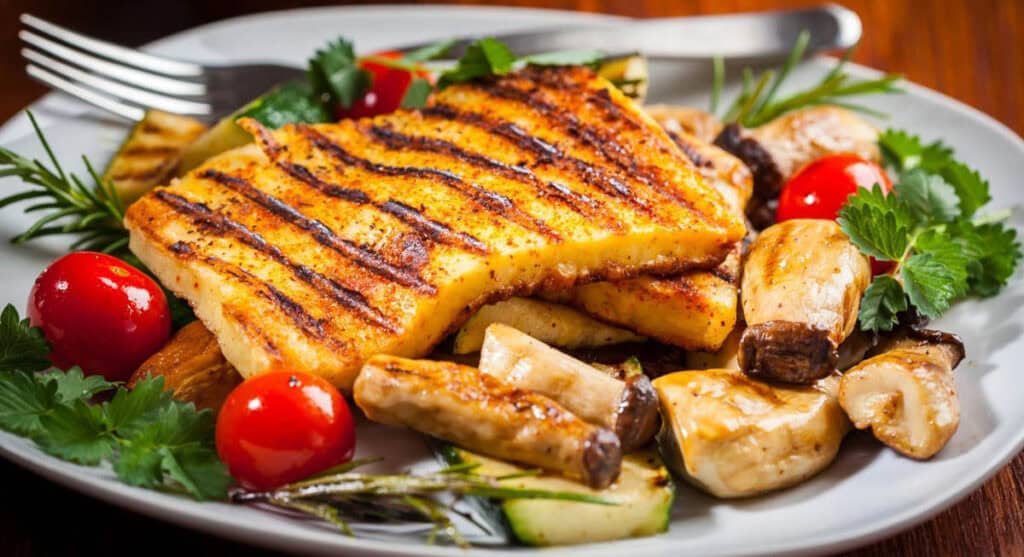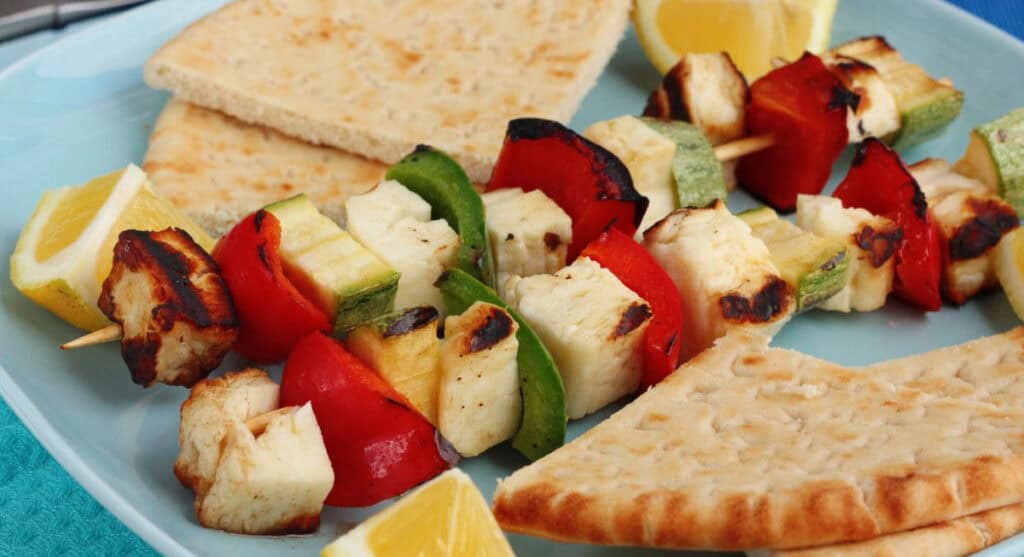If you’re a cheese lover, there’s a good chance you’ve heard of halloumi cheese. Halloumi’s salty, savory flavor and unique texture set it apart from other cheeses, making it a versatile ingredient in many dishes.

You can use it in sandwiches, salads or as a stand-alone snack — the possibilities are endless. But if you’ve never tried cooking with halloumi before, you might wonder where to start.
This guide covers everything you need to know, from finding halloumi to various preparation methods. With this delicious and versatile cheese, you can take your culinary skills to the next level.
What is halloumi?
Halloumi is a semi-hard cheese made from a combination of goat’s, sheep’s and sometimes cow’s milk. It is known for its unique texture and high melting point, making it perfect for grilling or frying.
Cyprus is the birthplace of halloumi cheese. It has been produced here for centuries, largely in rural villages. Traditional cheese-making recipes have been passed down through generations, preserving the authentic flavor and texture.
The cheese is often prepared using raw milk, and the curds are cooked at a high temperature before being set in brine. This process gives halloumi its distinctive layered texture and squeaky feel when eaten fresh.
Halloumi has gained global popularity in recent years because of its firm texture. The cheese doesn’t fall apart and melts when heated, allowing you to enjoy perfect grill marks.
What does halloumi taste like?
Halloumi offers a unique and delightful flavor experience. When you take your first bite, you’ll notice its salty taste, reminiscent of feta.
Its texture is firm and slightly rubbery when fresh. Grilling or frying turns it into a crisp and golden delight with a creamy interior, enhancing its taste. Here are the most notable characteristics of halloumi’s taste:
- Salty: More pronounced than most cheeses.
- Mild: It is not overpowering, so it is versatile.
- Slightly tangy: Adds depth to its flavor profile.
Halloumi stands out in dishes, whether in salads, sandwiches or as a grilled delicacy. Once heated, it develops a savory, creamy richness that’s difficult to resist.
“I love making halloumi fries because the cheese is perfect for it. It keeps its shape when baked and doesn’t melt, so I always get delicious fries. I cut the halloumi into thick slices, coat them with flour, cornstarch and spices and bake until golden.”
— Sara Nelson, Real Balanced

Cooking with halloumi
While halloumi can be eaten without cooking, heating it enhances its flavor. It can be grilled, pan-fried, air-fried or baked.
Preparation
Before cooking, cut the halloumi into slices, usually about one-quarter to one-third inch thick. Avoid cutting it too thin, so it holds up to the heat. Rinse it under cold water to remove excess brine, and pat dry with a paper towel.
Lightly brushing olive oil enhances the flavor and prevents sticking. Halloumi’s high melting point allows it to be cooked without losing shape, making it ideal for high-heat cooking methods like grilling, pan-frying or air-frying.
Grill
To grill halloumi, preheat your grill to medium-high heat. Place the slices directly on the grill grates for two to three minutes per side.
The cheese will develop golden grill marks and a slightly crispy exterior. For added zest, serve grilled halloumi with lemon juice or herbs. It pairs well with grilled vegetables or pita bread.
Pan-fry
Pan-frying halloumi provides a quick and easy option. Heat a non-stick skillet over medium heat and add some olive oil.
Cook the slices on each side for two to three minutes until they turn golden brown and crispy. Pan-fried halloumi is perfect for breakfast sandwiches or served with a drizzle of honey.
Air Fry
Air frying has become an increasingly popular cooking method, and it’s an excellent way to prepare halloumi cheese. Air frying allows you to achieve a crispy exterior and a soft, gooey interior without the need for excessive oil.
Preheat your air fryer to 400 F. Place the halloumi slices in a single layer in the air fryer basket, ensuring they don’t overlap. Cook for four to five minutes or until the slices are golden brown and crisp outside. Halloumi is also the perfect cheese to use for air fryer cheese sticks.
Bake
Baking is another excellent way to prepare halloumi cheese, resulting in a warm, soft and slightly crispy texture. Bake the halloumi at 400 F for 10 to 15 minutes or until it turns golden brown and crispy around the edges. Keep an eye on the cheese as it bakes, as cooking times may vary depending on your oven and the thickness of the slices.

Using it in recipes
Halloumi is versatile, and it can be used in many different recipes. Try adding it to kabobs along with vegetables and grilling. You can also use halloumi in sandwiches and wraps or as a pizza topping.
Halloumi adds texture and flavor to salads. Combine it with greens, tomatoes, cucumbers and olives in a Mediterranean-style salad or a classic Caprese salad.
Cube halloumi and toss it in olive oil and herbs before adding to your salad. It also complements sides like roasted vegetables or quinoa, enhancing the entire dish.
It pairs well with Mediterranean ingredients like tomatoes, basil and olives. Its unique taste and texture make it versatile and enjoyable in numerous dishes.
Where to buy halloumi
Halloumi cheese is available at many locations, both in person and online. Many large supermarket chains stock it in the cheese or specialty foods section.
Health food stores and organic markets frequently carry halloumi, sometimes with a unique selection of imported cheeses. Local farmers’ markets may offer halloumi, especially those with vendors specializing in cheese or Mediterranean foods.
Specialty cheese shops and online retailers offer a diverse selection of cheeses, including halloumi. Websites like Amazon, Walmart and specialty food retailers offer delivery right to your door.
Storage tips
Proper storage is crucial to keeping your halloumi fresh and flavorful. When unopened, store the package in the refrigerator. Halloumi typically lasts several months before opening.
Once opened, keep the cheese submerged in its brine to maintain its texture and taste. Store in an airtight container to prevent the cheese from drying out and absorbing other odors. Once opened, it is best to use halloumi within a week.
If you don’t have brine available, you can also tightly wrap halloumi in plastic wrap or aluminum foil for short-term storage. Freezing halloumi is also an option. Cut it into small pieces, wrap each piece in plastic and place them in a freezer bag. Thaw frozen halloumi in the fridge before cooking.
Summing up
Halloumi cheese is a delightful and versatile ingredient that deserves a place in every cheese lover’s kitchen. Its unique texture, high melting point and salty flavor make it perfect for grilling, frying or adding to salads and other dishes.
Whether you’re a long-time cheese lover or just starting to explore new ingredients, halloumi is an excellent choice for adding a touch of Mediterranean flair to your meals. Discover the endless possibilities this delicious cheese has to offer.
Anne Jolly is the creator of the food blog Upstate Ramblings. She loves to cook with gadgets like an air fryer, sous vide or pressure cooker.